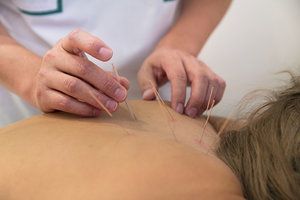Chronic pain afflicts over 20% of the adult population. Sadly, most MDs have essentially no education in treating pain, beyond offering a few toxic medications. Then they tend to steer people with pain away from those health practitioners who are trained. This puts the acupuncture community on the front lines for addressing this epidemic.
Window of the Sky Points
The acupuncture points known as Window of the Sky are a modern creation. There is no reference in Chinese medical texts for an acupuncture point category called Window of the Sky. The history of this category of points is very interesting. Chapter 21 of the Ling Shu, "Cold and Hot Diseases," presents a variety of points that treat conditions including muscular pain, rheumatism and conditions of the face and neck (the chapter also lists acupuncture points by regions of the body, information about the luo collaterals and a type of seasonal treatment). There are five points listed together in one paragraph, and in the following paragraph the conditions they treat are listed. There is no group or category name for the five points. The chapter presents five points, not the current ten points commonly presented as the Window of the Sky points. The classical function of these five points is basically treating the imbalanced flow of qi and blood. The following summarizes the function for each of the five points.
Man's Receptor – Ren Ying - Stomach 9
When Yang is rebellious and there is counter-flow, there is pain in the head. The chest is full and one is unable to take breath normally. For this condition, treat Man's Receptor.
Supporting Chimney – Fu Tu - Large Intestine 18
When there is an abrupt loss of speech, the qi hardens; treat Supporting Chimney.
Celestial Pillar – Tian You - San Jiao 16
When there is an abrupt loss of hearing, the qi becomes covered and blocked, and the ears and eyes lose their brightness; treat Celestial Pillar. Another translation of this acupuncture point name is Celestial Window.
Wind Pillar – Tian Zhu – Bladder 10
When there are spasms, convulsions, and dizziness, and the feet are unable to bear the body; treat Wind Pillar.
Celestial Mansion – Tian Fu - Lung 3
An abrupt thirst and fever, the interior is rebellious and in counter-flow, causing the liver and lungs to strike at each other. And blood overflows from the nose and mouth; treat Celestial Mansion.

There is no name for this group of five points. The earliest reference to this group of five points as Widow of the Sky points appears to be from Dr. Albert Chamfrault. The name "window of the sky" appeared in print in 1954, in Dr. Albert Chamfrault's book: Traite de Medecine Chinoise, Tome 1: Acupuncture, Moxas, Massages, Saignees, Editions Coquemard, Angouleme, France. The name was most likely based on the acupuncture point Celestial Window, San Jiao 16.
Dr. Albert Chamfrault calls the five points in chapter 21 of the Ling Shu, the Big Window of the Sky points. Dr. Nguyen Van Nghi uses the name Five Great Windows of Heaven (Tian Wu Bu) is his translation of chapter 21 of the Ling Shu for the same five points. Van Nghi states, "The 5 Great windows" cited in the previous chapter are grouped under the name Tian You Wu Bu (group of 5 Great windows of the heaven).
The Ten Points
In chapter 2 of the Ling Shu, "The Roots of the Acupuncture Points," a series of acupuncture points are presented by region of the body. One of the regions includes the following 10-points: "In the middle of the body between the Broken Dish (supraclavicular fossae), is the Conception Vessel. This point is called Celestial Chimney. On the first line following the sides of the Conception Vessel are beating pulses (carotid pulses) on the Leg Bright Yang at points called Man's Receptor. The second line from the channel of the Conception Vessel is the Arm Bright Yang at points called Supporting Chimney. The third line from the channel is the Arm Major Yang with points called Celestial Window. The fourth line from the channel is the Arm Minor Yang at points called Celestial Shutters. The sixth line from the channel is the Leg Major Yang at points called Celestial Pillar. The seventh line from the channel is on the Governing Vessel Channel right through the middle of the neck. The point is called Wind Pillar. On the further side of it is the point Wind Mansion. In the fossa of the armpit, is a beating pulse on the Arm Major Yin. This point is called Celestial Mansion. Below the armpit by three cun is the Arm Pericardium Channel. This point is called Tian Fu Celestial Pool."
There are no functions listed in chapter 2 of the Ling Shu. All the functions of these ten points and this new category began in the 1950's.
Table 1: The Ten Points (Window of the Sky Points)
| English Name | Acupoint | Pin Yin Name |
| Celestial Chimney | Ren 22 | Tian Tu |
| Man's Receptor/Prognosis | Stomach 9 | Ren Ying * |
| Supporting Chimney | Large Intestine 18 | Fu Tu * |
| Celestial Window | Small Intestine 16 | Tian Chuang |
| Celestial Shutters/Appearance | Small Intestine 17 | Tian Rong |
| Celestial Pillar/Window | San Jiao 16 | Tian You * |
| Wind Pillar/Celestial Pillar | Bladder 10 | Tian Zhu * |
| Wind Mansion | Du 16 | Feng Fu |
| Celestial Mansion/Storehouse | Lung 3 | Tian Fu * |
| Celestial Pool | Pericardium 1 | Tian Chi |
| * The five points in chapter 21 of the Ling Shu. | ||
Dr. Chamfrault and Dr. Van Nghi collaborated to name the other five points found in chapter 2 of the Ling Shu the Little Window of the Sky points. Eventually, all ten were named the Window of the Sky points. This new group of points and their new functions was spread around the world. Everyone that teaches and uses these ten points as the Window of the Sky points is following the work of Dr. Chamfrault and Dr. Van Nghi. This acupuncture point category and the common functions are not based on any Chinese medical source.
The following is a list of some common ways the Window of the Sky points are promoted:
- Connects a person to their spiritual self.
- Connects a person to the celestial realm for guidance (heavenly realm).
- Highly evocative locations that take people to a hypnagogic realm.
- Used to facilitate past-life work.
- Used to induce a person into previous incarnations.
- Releases emotional trauma from current or decades old experiences.
- Meditate between thought, action and feeling.
During the long history of Chinese medicine, there has been new additions of acupuncture point categories and applications that have little or no theory and explanation. Understanding the history of new acupuncture point categories allows the practitioner to evaluate the basis of their development and then decide whether to use them in clinical practice. I hope this article inspires discussion and analysis about the acupuncture point category Window of the Sky points.
References:
- Lu, H. (1985) A Complete Translation of The Yellow Emperor's Classic of Internal Medicine and the Difficult Classic. Vancouver: Academy of Oriental Heritage.
- Nghi, Van Nguyen, Tran, Dzung, (2002) Huang Di Nei Jing Ling Shu. Sugar Grove, NC: Jung Tao School of Classic Chinese Medicine.
- McDonald, John, TCM Central.com, Curtains for the Window of the Sky.
- Twicken, D. (2015) The Luo Collaterals, A Handbook for Clinical Practice. London: Singing Dragon.
- Wu, J. (2002) Ling Shu or The Spiritual Pivot. Hawaii: University of Hawaii Press.
- Wu, N., and Wu, A. (2002) Yellow Emperor's Canon of Internal Medicine. Beijing: China Science Technology Press



